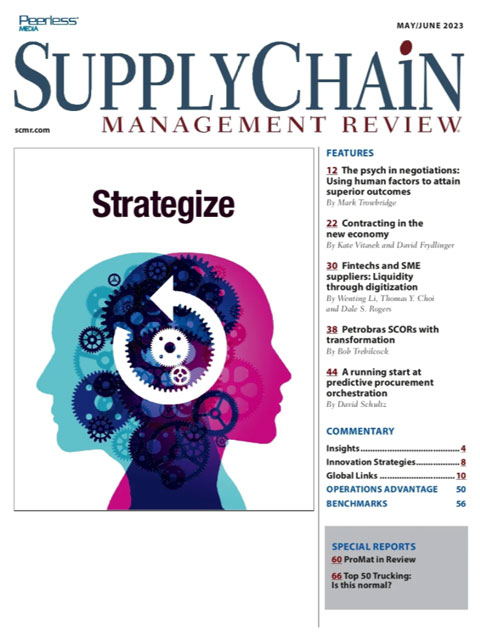Sorry, but your login has failed. Please recheck your login information and resubmit. If your subscription has expired, renew here.
May-June 2023
If you were dropped onto this planet and landed at McCormick Place in the heart of Chicago in the middle of March, you would probably conclude that planet Earth had been overrun by robots. Everywhere you turned on the ProMat conference floor, there was a robot lifting something, putting something away, or carrying something to another location. But, despite a conference hall overrun by technology, the on-the-ground reality is a bit different. Not so long ago, commercial real estate firm Prologis estimated the number of facilities with any type of automation at about 10%. But that is changing—quickly. A recent report from JLL found that one-in-two… Browse this issue archive.Need Help? Contact customer service 847-559-7581 More options
The looming liquidity crisis is threatening small-and-medium-sized enterprises (SMEs). Across all supply chains, SMEs represent 90% of all enterprises worldwide, and they have been suffering. According to a 2020 study by the Organization for Economic Cooperation and Development (OECD), 20% of SMEs could run out of their cash reserve within one month. Their average bankruptcy rate could rise to 12.1% from 4.5% if there is no effective policy
intervention. The Wall Street Journal reports that, in the United States, 25% of SMEs shut down in 2020. Despite governments issuing policies and special treatments to protect SMEs, their liquidity shortages remain unsolved.
A new breed of supply chain financing service providers called fintechs (i.e., financial technology companies) could offer potential solutions. They would digitize the assets (i.e., approved invoices, inventories, etc.) of SME suppliers and avail the related financial information to interested parties (i.e., focal companies, investors, etc.). We introduce in this article how fintechs can help the SMEs and their liquidity problems. We begin by categorically recounting the economic and supply chain conditions SMEs are operating under.
Problems SMEs face
SMEs lack funding from banks and their buying firms to meet their operational liquidity needs. There were $1.5 trillion to $2.6 trillion credit gaps in 2019, according to a report filed by Asian Development Bank (ADB). The World Trade Organization (WTO) estimated it could have been $1.9 trillion to $5.1 trillion in 2020. What are the sources of the credit gaps?
Credit barriers
It is difficult for SMEs to get financing from commercial banks. This is because SMEs
generally lack collateral or reliable financial records. Even when they work with banks, they have to bear the burden of high loan rates and limited loan sizes.
Consequently, many SMEs turn to their internal funds and personal sources. A 2022 survey by The Business News Daily shows that one-half of small businesses, including startups, rely on loans from their families and friends. These personal sources do not require collateral, and SMEs can take flexible repayment plans and interest rates. However, this informal financing channel is unreliable, availability intermittent and limited.

This complete article is available to subscribers only.
Log in now for full access or start your PLUS+ subscription for instant access.
SC
MR
Sorry, but your login has failed. Please recheck your login information and resubmit. If your subscription has expired, renew here.
May-June 2023
If you were dropped onto this planet and landed at McCormick Place in the heart of Chicago in the middle of March, you would probably conclude that planet Earth had been overrun by robots. Everywhere you turned on the… Browse this issue archive. Access your online digital edition. Download a PDF file of the May-June 2023 issue.
The looming liquidity crisis is threatening small-and-medium-sized enterprises (SMEs). Across all supply chains, SMEs represent 90% of all enterprises worldwide, and they have been suffering. According to a 2020 study by the Organization for Economic Cooperation and Development (OECD), 20% of SMEs could run out of their cash reserve within one month. Their average bankruptcy rate could rise to 12.1% from 4.5% if there is no effective policy
intervention. The Wall Street Journal reports that, in the United States, 25% of SMEs shut down in 2020. Despite governments issuing policies and special treatments to protect SMEs, their liquidity shortages remain unsolved.
A new breed of supply chain financing service providers called fintechs (i.e., financial technology companies) could offer potential solutions. They would digitize the assets (i.e., approved invoices, inventories, etc.) of SME suppliers and avail the related financial information to interested parties (i.e., focal companies, investors, etc.). We introduce in this article how fintechs can help the SMEs and their liquidity problems. We begin by categorically recounting the economic and supply chain conditions SMEs are operating under.
Problems SMEs face
SMEs lack funding from banks and their buying firms to meet their operational liquidity needs. There were $1.5 trillion to $2.6 trillion credit gaps in 2019, according to a report filed by Asian Development Bank (ADB). The World Trade Organization (WTO) estimated it could have been $1.9 trillion to $5.1 trillion in 2020. What are the sources of the credit gaps?
Credit barriers
It is difficult for SMEs to get financing from commercial banks. This is because SMEs
generally lack collateral or reliable financial records. Even when they work with banks, they have to bear the burden of high loan rates and limited loan sizes.
Consequently, many SMEs turn to their internal funds and personal sources. A 2022 survey by The Business News Daily shows that one-half of small businesses, including startups, rely on loans from their families and friends. These personal sources do not require collateral, and SMEs can take flexible repayment plans and interest rates. However, this informal financing channel is unreliable, availability intermittent and limited.
SC
MR


More Finance
- Services sector sees growth in October, reports ISM
- Looking back at NextGen 2024
- Manufacturing again contracts in October, reports ISM
- NextGen Supply Chain Conference set for October 21-23
- Estée Lauder, Schneider Electric and S&S Activewear to receive NextGen End User awards
- 2024 Robotics Application Conference announces session, speaker lineup
- More Finance
Latest Podcast

 Explore
Explore
Business Management News
- Strengthening customer fulfillment: Building a strategic stakeholder network
- The hard job of teaching soft skills
- Trump picks former Wisconsin congressman Sean Duffy for DOT secretary
- Made in Mexico, manufactured by China
- Retail sales see gains in October, reports Commerce and NRF
- Balancing green and speed: Home delivery insights from the pandemic era
- More Business Management
Latest Business Management Resources

Subscribe

Supply Chain Management Review delivers the best industry content.

Editors’ Picks





